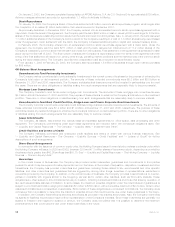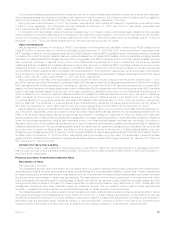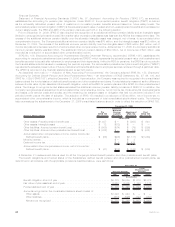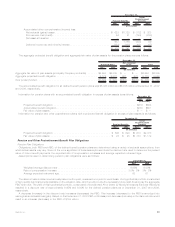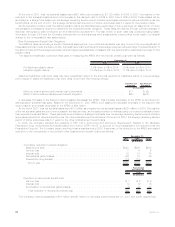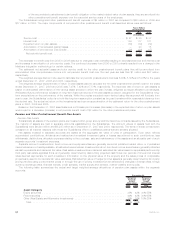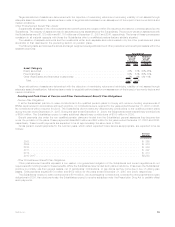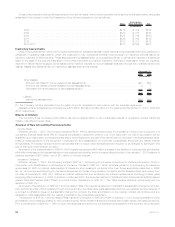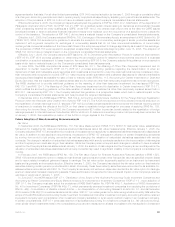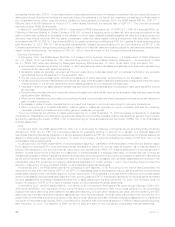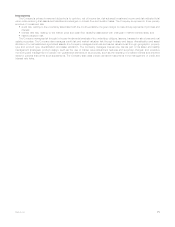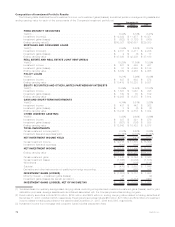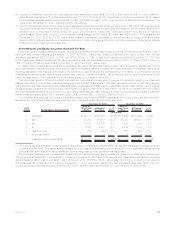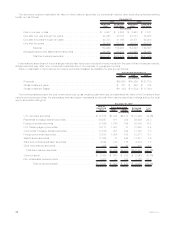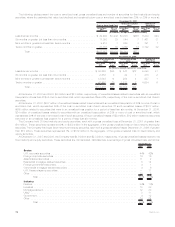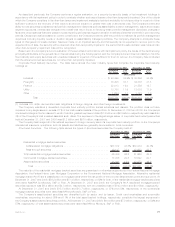MetLife 2007 Annual Report Download - page 72
Download and view the complete annual report
Please find page 72 of the 2007 MetLife annual report below. You can navigate through the pages in the report by either clicking on the pages listed below, or by using the keyword search tool below to find specific information within the annual report.itself does not contain an embedded derivative (including an interest rate-related derivative) for which bifurcation would be required
other than an embedded derivative that results solely from the embedded call options in the underlying financial assets. The adoption
of Issue B40 did not have a material impact on the Company’s consolidated financial statements.
• Effective January 1, 2006, the Company adopted prospectively SFAS 133 Implementation Issue No. B38, Embedded Derivatives:
Evaluation of Net Settlement with Respect to the Settlement of a Debt Instrument through Exercise of an Embedded Put Option or Call
Option (“Issue B38”) and SFAS 133 Implementation Issue No. B39, Embedded Derivatives: Application of Paragraph 13(b) to Call
Options That Are Exercisable Only by the Debtor (“Issue B39”). Issue B38 clarifies that the potential settlement of a debtor’s obligation
to a creditor occurring upon exercise of a put or call option meets the net settlement criteria of SFAS 133. Issue B39 clarifies that an
embedded call option, in which the underlying is an interest rate or interest rate index, that can accelerate the settlement of a debt
host financial instrument should not be bifurcated and fair valued if the right to accelerate the settlement can be exercised only by the
debtor (issuer/borrower) and the investor will recover substantially all of its initial net investment. The adoption of Issues B38 and B39
did not have a material impact on the Company’s consolidated financial statements.
Other
Effective January 1, 2007, the Company adopted FASB Staff Position (“FSP”) Emerging Issues Task Force (“EITF”) 00-19-2, Accounting
for Registration Payment Arrangements (“FSP EITF 00-19-2”). FSP EITF 00-19-2 specifies that the contingent obligation to make future
payments or otherwise transfer consideration under a registration payment arrangement should be separately recognized and measured in
accordance with SFAS No. 5, Accounting for Contingencies. The adoption of FSP EITF 00-19-2 did not have an impact on the Company’s
consolidated financial statements.
Effective January 1, 2007, the Company adopted FSP No. FAS 13-2, Accounting for a Change or Projected Change in the Timing of
Cash Flows Relating to Income Taxes Generated by a Leveraged Lease Transaction (“FSP 13-2”). FSP 13-2 amends SFAS No. 13,
Accounting for Leases, to require that a lessor review the projected timing of income tax cash flows generated by a leveraged lease
annually or more frequently if events or circumstances indicate that a change in timing has occurred or is projected to occur. In addition,
FSP 13-2 requires that the change in the net investment balance resulting from the recalculation be recognized as a gain or loss from
continuing operations in the same line item in which leveraged lease income is recognized in the year in which the assumption is changed.
The adoption of FSP 13-2 did not have a material impact on the Company’s consolidated financial statements.
Effective January 1, 2007, the Company adopted SFAS No. 156, Accounting for Servicing of Financial Assets — an amendment of
FASB Statement No. 140 (“SFAS 156”). Among other requirements, SFAS 156 requires an entity to recognize a servicing asset or servicing
liability each time it undertakes an obligation to service a financial asset by entering into a servicing contract in certain situations. The
adoption of SFAS 156 did not have an impact on the Company’s consolidated financial statements.
Effective November 15, 2006, the Company adopted SAB No. 108, Considering the Effects of Prior Year Misstatements when
Quantifying Misstatements in Current Year Financial Statements (“SAB 108”). SAB 108 provides guidance on how prior year misstatements
should be considered when quantifying misstatements in current year financial statements for purposes of assessing materiality. SAB 108
requires that registrants quantify errors using both a balance sheet and income statement approach and evaluate whether either approach
results in quantifying a misstatement that, when relevant quantitative and qualitative factors are considered, is material. SAB 108 permits
companies to initially apply its provisions by either restating prior financial statements or recording a cumulative effect adjustment to the
carrying values of assets and liabilities as of January 1, 2006 with an offsetting adjustment to retained earnings for errors that were
previously deemed immaterial but are material under the guidance in SAB 108. The adoption of SAB 108 did not have a material impact on
the Company’s consolidated financial statements.
Effective January 1, 2006, the Company adopted prospectively EITF Issue No. 05-7, Accounting for Modifications to Conversion
Options Embedded in Debt Instruments and Related Issues (“EITF 05-7”). EITF 05-7 provides guidance on whether a modification of
conversion options embedded in debt results in an extinguishment of that debt. In certain situations, companies may change the terms of
an embedded conversion option as part of a debt modification. The EITF concluded that the change in the fair value of an embedded
conversion option upon modification should be included in the analysis of EITF Issue No. 96-19, Debtor’s Accounting for a Modification or
Exchange of Debt Instruments, to determine whether a modification or extinguishment has occurred and that a change in the fair value of a
conversion option should be recognized upon the modification as a discount (or premium) associated with the debt, and an increase (or
decrease) in additional paid-in capital. The adoption of EITF 05-7 did not have a material impact on the Company’s consolidated financial
statements.
Effective January 1, 2006, the Company adopted EITF Issue No. 05-8, Income Tax Consequences of Issuing Convertible Debt with a
Beneficial Conversion Feature (“EITF 05-8”). EITF 05-8 concludes that: (i) the issuance of convertible debt with a beneficial conversion
feature results in a basis difference that should be accounted for as a temporary difference; and (ii) the establishment of the deferred tax
liability for the basis difference should result in an adjustment to additional paid-in capital. EITF 05-8 was applied retrospectively for all
instruments with a beneficial conversion feature accounted for in accordance with EITF Issue No. 98-5, Accounting for Convertible
Securities with Beneficial Conversion Features or Contingently Adjustable Conversion Ratios, and EITF Issue No. 00-27, Application of
Issue No. 98-5 to Certain Convertible Instruments. The adoption of EITF 05-8 did not have a material impact on the Company’s
consolidated financial statements.
Effective January 1, 2006, the Company adopted SFAS No. 154, Accounting Changes and Error Corrections, a replacement of APB
Opinion No. 20 and FASB Statement No. 3 (“SFAS 154”). SFAS 154 requires retrospective application to prior periods’ financial statements
for a voluntary change in accounting principle unless it is deemed impracticable. It also requires that a change in the method of
depreciation, amortization, or depletion for long-lived, non-financial assets be accounted for as a change in accounting estimate rather
than a change in accounting principle. The adoption of SFAS 154 did not have a material impact on the Company’s consolidated financial
statements.
In June 2005, the EITF reached consensus on Issue No. 04-5, Determining Whether a General Partner, or the General Partners as a
Group, Controls a Limited Partnership or Similar Entity When the Limited Partners Have Certain Rights (“EITF 04-5”). EITF 04-5 provides a
framework for determining whether a general partner controls and should consolidate a limited partnership or a similar entity in light of
certain rights held by the limited partners. The consensus also provides additional guidance on substantive rights. EITF 04-5 was effective
after June 29, 2005 for all newly formed partnerships and for any pre-existing limited partnerships that modified their partnership
68 MetLife, Inc.


